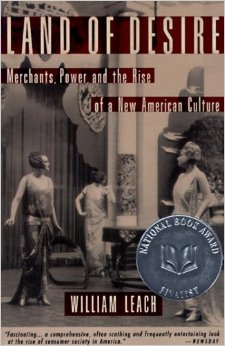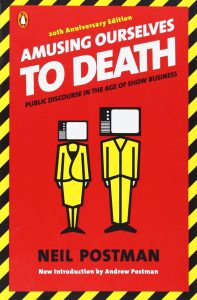In Land of Desire: Merchants, Power, and the Rise of a New American Culture, William Leach examined the “crucial formative years” of consumer capitalism in the United States (xiii). From 1880 to 1930, Americans transitioned from a society based on “traditional family or community values to a consumer capitalism society” (3). Capitalism created a “secular business and market oriented culture that featured “acquisition and consumption as a means of achieving happiness, the cult of the new, the democratization of desire and money as a significant measure of all value in society” (3). Leach argued that consumer culture “diminished American public life, denied Americans access to other ways of conceiving life and limited Americans insight that might have endowed their consent to the dominant culture with real democracy” (xv).
Before1880, the “culture in America consisted of an agrarian economy, republicans, religion; and most people — white people— controlled their own property of land” (8). By the end of the 19th century, however, the “Land of Comfort became the Land of Desire” (6). Investment banking, big businesses and department stores contributed to the rise of middle-class consumers. The Industrial Revolution led to the mass production of goods. Advertising, display and decoration, fashion, style, design and consumer service emerged as methods of marketing as new technology and machines produced goods quickly” (37).
“New visual media” emerged as a way to entice consumers early in the 20th century (38). Ad pictures, billboards, electrical signs, and glass show windows helped the “movement of goods” (40). Instead of simple copy advertisements, businesses favored advertisements that “appealed to the eye” (43). Merchants, such as Robert Ogden and John Wanamaker, hired “trained artists to prepare their ads” (52). Artists, such as Maxfield Parrish and L. Frank Baum, created pictorial and window advertisements that fostered year-round desire, caught “consumers’ attention and inspired a measure of loyalty” (60).
American businessmen began to use a “network of services” for personal and public benefit. Charge accounts and installment buying “eased the pain of purchasing” for consumers. (112). Retailers tailored installment buying to fit the needs of the middle-class. Between 1895 and 1915, industrial workers “revolted against industries and farmers organized populist uprisings” (117). Thus, businessmen “pursued a better public image” through consumer service (121). This allowed business employees to satisfy the consumers’ needs and desires. Merchants trained employees to treat consumers as “special people” (131). Other services, such as the return-goods policy, the free delivery system, tips, music and the inclusion of modern in department stores appealed to consumers’ fantasies. These services, however, also separated middle-class consumers from lower-class workers.
Public and private institutions contributed to the consumer culture. “Art schools, colleges and universities ‘opened their doors to serve the educational needs of business” (154). The rise of big department stores led to the creation of special subway stations and “the rerouting of bus and train stations to satisfy business institutions” (174). Museums helped spread the idea of “beauty to the masses” 173). Congress created government agencies, such as the Federal Reserve Board and Federal Trade Commission, to aid “business by facilitating the movement of goods outward in to foreign countries” (178). These corporations also favored and contributed to advertising in businesses.
Leach discussed the religious responses about moral issues of consumerism. Some people combined consumer pleasure with the idea of traditional Christian views. Mind curers believed “they could shape their own destiny and find total happiness through desire, consumption and abundance” (227). Political economists, such as Simon Patten, believed that ‘the constant addition of new goods into people’s budgets made more ethical individuals” (238). Thus, according to the law or marginal utility, individuals will “consume more of a commodity, each increment will become less, inducing the consumer to buy other goods” (238).
In the early 1920s, the rise of “consumptionism” took place in American society. Samuel Strauss, a journalist and political philosopher, argued that “consumptionism emphasized the standard of living above all other virtues” (268). The increase in the mass production of consumer goods, the rise of chain stores and the power of advertising “enticed people to buy what was not wanted” (268). Installment buying, charge accounts and small loans “engulfed consumers in a sea of easy credit” (299). As a result, businesses implemented a new managerial role to entice consumers. “Greater investment in mass production required greater skill in mass seduction” (298). Thus, businesses “sold consumers their dream” (299).
As business demands grew, Herbert Hoover believed that the government should play a role in creating “permanent prosperity” (355). By 1929, the “American capitalist culture of consumption had finally taken root” (378). Many legacies of this time period exist in society today, but as Leach stated, “America’s standard of living is declining” (390). “The fundamental American conviction that the next generation will be better off than the one prior to it is on the brink of being dashed” (390).



